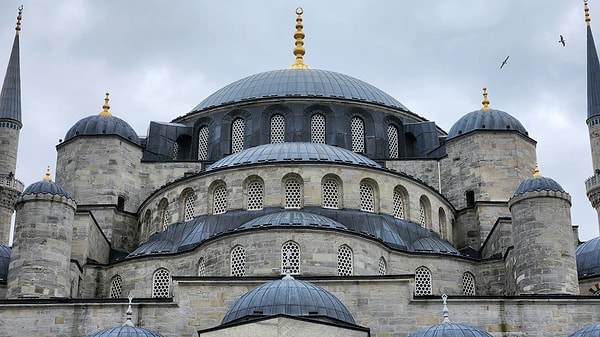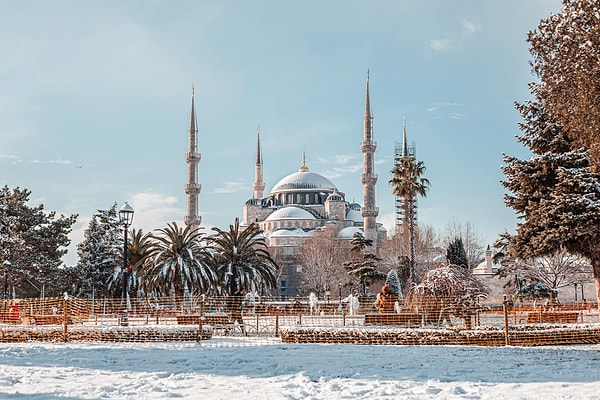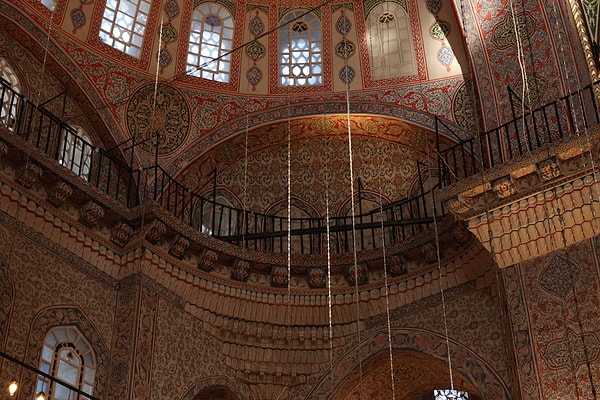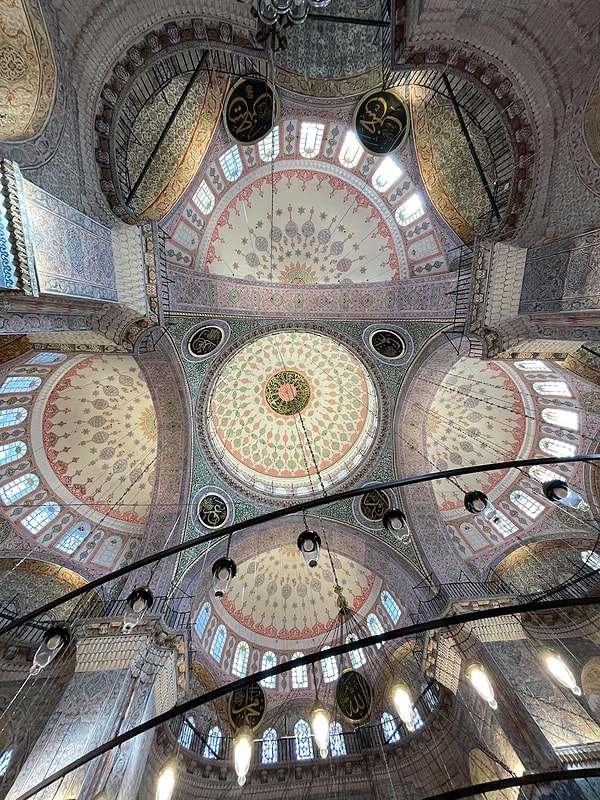Where is the Blue Mosque? Discover the History and Architecture of Sultan Ahmed Mosque
Sultan Ahmet Mosque, one of the most magnificent buildings in Istanbul, was built by Sedefkâr Mehmed Ağa in the 17th century. The architect of Sultan Ahmet Mosque, whose construction was completed in 1617, was a student of Mimar Sinan. Sultan Ahmet Mosque, which is considered a monumental work, is a work belonging to the classical period of Ottoman architecture. This work is an important example of Turkish-Islamic art. Sultan Ahmet Mosque is known for its minarets and blue colours. Hence why it is called the Blue Mosque by visitors. So, where is Sultan Ahmet Mosque? How to visit the Sultan Ahmet Mosque? Why is it called the Blue Mosque? Let's explore together👇
Where is Sultan Ahmet Mosque?

Sultan Ahmet Mosque is located in Istanbul. It is located exactly in Sultanahmet Square, known as the historical peninsula of Istanbul. For this reason, Sultan Ahmet Mosque is located in Sultanahmet Square. Sultanahmet, one of the historical and touristic centres of Istanbul, is famous for its mosque, Hagia Sophia Museum, Topkapi Palace and other important historical buildings. The Sultan Ahmet Mosque is one of the most iconic and well-known mosques in Istanbul, and it attracts visitors as one of the city's tourist attractions.
Address: Binbirdirek, At Meydanı Cd No:10, 34122 Fatih/Istanbul
How to get to the Sultan Ahmet Mosque?

If you want to easily reach Sultan Ahmet Mosque, which is located within the borders of the Fatih district in the Historical Peninsula, we recommend that you choose the Bağcılar-Kabataş tram line. This stop of the tram line is located on the road right in front of the mosque.
If you are coming from the Anatolian side, you can choose Eminönü ferries departing from Kadıköy or Üsküdar. When you get off the ferry, you can take the Bağcılar-Kabataş line from the tram stop in Eminönü. If you don't want to take the ferry, you may prefer Marmaray when coming to Sultan Ahmet. You can get off at Sirkeci stop on Marmaray and transfer to the Bağcılar-Kabataş line.
If you are coming to Sultan Ahmet Mosque by private car, it is useful to know that the streets around it are closed to traffic.
Sultan Ahmet Mosque Entrance Fees and Opening Hours

Pricing: Entrances are free of charge
Working Hours: Open 24 hours a day.
Architect: Sedefkâr Mehmed Aga
Opening date: 1616
Capacity: 10.000
Construction start date: 1609
Architectural styles: Islamic Architecture, Ottoman Architecture
People buried in: Sultan Ahmed I, Kösem Sultan, Murad IV, Osman II, Gevherhan Sultan, Şehzade Süleyman
How Much Time Should You Spend Visiting Sultan Ahmet Mosque?
If you did not choose to go in winter, you should be prepared to wait for 1 hour at the gate. After waiting for 1 hour and going inside, it will take you 10 to 20 minutes to visit the mosque.
Things to Consider at Sultan Ahmet Mosque

The first element you need to pay attention to is dress and attire. In this religious building, which is open for worship, you are asked to pay attention to what you wear out of respect for spiritual values and the worshippers inside. You cannot enter with a mini skirt, shorts, off-the-shoulder or sleeveless blouse and with your top and head uncovered. For this reason, it is useful to pay attention to this in the summer season. The mosque has found a solution for tourists by providing one-piece clothes made of fabric in the cabins at the entrance.
Silence is a second important point in this mosque, where places of worship and visitation are separated. Such an important rule has been put in place in order to prevent the people worshipping inside from being affected by the noise.
It is worth mentioning that the iftar tents of the municipality are here during Ramadan. Because of these iftar tents set up in Sultan Ahmet Square, there is a crowd waiting to break fast in the garden of the mosque.
Arasta Bazaar, which is located in the same complex as the Sultan Ahmet Mosque, is a popular place for shopping. Especially if you come from far away, if you want to buy souvenirs and souvenirs of the day you visited, this bazaar is for you.
History of Sultan Ahmet Mosque

It was Sultan Ahmet I who ascended the throne at the age of 14 and asked for a mosque to be built in his name at the age of 19. Sultan Ahmet I wanted this mosque to be seen from all over Istanbul. In addition, he wanted this mosque to be at the forefront in its artistic aspect. For this reason, he agreed with the architect Sedefkar Mehmet Aga, who was both an architect and a mother-of-pearl master.
In the 17th century, when the Sultan Ahmet Mosque was built, the economic power of the Ottoman Empire had weakened considerably. At this time, the Ottoman Empire was losing territory, and rebellions had started in Anatolia. When the Sultan Ahmet Mosque was built, not from the spoils of war but from the state treasury, the reactions grew like an avalanche.
It was built between 1590 and 1617 as a complex. First, the mosque, then the arasta and finally the hünkar pavilion sections were opened with a ceremony. Ahmet I died at the age of 27 and was buried in the Sultan Ahmet Mosque.
Sultan Ahmet Mosque and 6 minarets

Hagia Sophia wanted to surpass the Temple of Solomon in Jerusalem, and Süleymaniye wanted to surpass Hagia Sophia. At the end of this rivalry, it was decided that Sultan Ahmet Mosque would only surpass Hagia Sophia in order not to disrespect its ancestors. Sultan Ahmet Mosque was built as a magnificent structure with 6 minarets, unique in Ottoman history. However, these 6 minarets have caused some controversy. At the time it was built, having 6 minarets was characterised as disrespect to the mosque in the Kaaba. To put an end to these debates, Sultan Ahmet I had the 7th minaret added to the mosque in Kaaba.
Architectural Features of Sultan Ahmet Mosque

Sultan Ahmet Mosque was completed as a complex between 1590-1617. Inside the complex;
The Mosque
Hünkar Pavilion
Sibyan school
Madrasa
Arasta
Darussifa
Imarethane
Guest House
Mausoleums
Needless to say, the most eye-catching part of this complex is the mosque. The mosque is surrounded by walls with windows and eight doors. There are large courtyards at the front and sides of the mosque. An iron chain hangs above the entrances to the courtyard in the west. The reason for this is that even if you are a sultan, you should respect the mosque and behave yourself.
Interior Architecture of Sultan Ahmet Mosque

If we talk about the interior of the mosque, it consists of 26 columns, 30 domes, a square and a marble inner courtyard with a fountain. It is designed on a square plan with a main dome of 24 meters in diameter and 43 meters in height. The main dome is carried by four elephant legs, each five meters in diameter. With a total of 260 windows arranged in 5 rows in the main dome and half domes, a brightness that is not found in any mosque welcomes you in the Sultan Ahmet Mosque.
There are 3 doors through which you can enter the mosque. When you enter through the main door, the Hippodrome door, you will see the marble mihrab and the minbar next to it. In this section, you can see how Mehmet Aga successfully combined his architecture with his painting. It is worth noting that Mehmet Aga was a student of Mimar Sinan.
Blue Mosque or Sultan Ahmet Mosque?

Enter the mosque through any door and you are greeted by a tiled, ornate and colourful landscape. All the walls are covered with blue, green, red and turquoise colored tiles with predominantly plant motifs.
Sultan Ahmet Mosque is known as the “Blue Mosque” among tourists. The reason for this is the blue-toned interior appearance caused by the blue tiles.
Keşfet ile ziyaret ettiğin tüm kategorileri tek akışta gör!

Send Comment